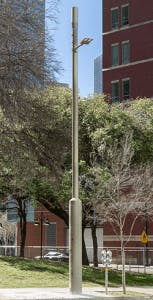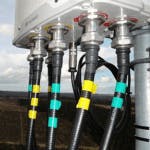How to Reduce “Not Spots”
The unquenching thirst for mobile capacity has continued to grow for many years, with the last 10 years seeing the introduction of the smartphone and ability for users to easily upload, download, and share apps, music, and videos, and livestream the major (and minor) events of their lives. The introduction of 5G networks will only serve to continue, or even accelerate this trend by introducing new innovative services, with 5G standards calling for ten times the throughput of LTE networks.
Higher throughput can be managed in a variety of ways, as the last few decades have shown, with new radio technology, more efficient antennas, optimizing patterns, and adding frequency bands. However, another aspect of the 5G standards is the need for ultra-low latency.
Latency refers to how long it takes to send a signal/message/data and receive a response. Delays can result from processing of the signal as it is routed from node to node in the network, and even though the signals travel at the speed of light, there are delays in transporting the signal between those nodes. 5G is expected to be able to support latencies many times faster than today’s 20-40 ms latency on an LTE network.
Why do we want latencies to be so low? This, along with the higher throughput of 5G, will allow users to interact over distances in near-real time. Consider virtual reality or the games that could be played with anyone in the world — with no lag. Remote surgeries would be possible, with near-instantaneous feedback to a surgeon. And of course, driverless cars tied into a network and immediately aware of changes to lights or traffic conditions.
To accomplish these higher speeds and lower latencies, edge computing will be necessary. Edge computing decentralizes data, moving it from one or a few main locations, to many locations around the network. This moves the data closer to the end users, increasing throughput and lowering latency.
InvisiLight® Solution for Deploying Fiber
April 2, 2022Go to Market Faster. Speed up Network Deployment
April 2, 2022Episode 10: Fiber Optic Closure Specs Explained…
April 1, 2022Food for Thought from Our 2022 ICT Visionaries
April 1, 2022Edge computing and low latency will provide a basis for many new, as yet unplanned services, which will escalate the need for additional capacity and hence densification. Densification of a network refers to the increase of capacity in a given geographic area. There are many ways to do this, including massive Multiple Input Multiple Output (MIMO) architectures, beamforming, multibeam antennas, and increasing the number of cell sites; these all refer to outdoor methods.
Indoor wireless, which account for a reported 80% of initiated connections, can be considered a form of densification, and will also have to evolve to support 5G.
A few indoor wireless options include distributed antenna systems (DAS), C-RAN, and indoor small cells.
DAS is a network of low- and high-powered antennas distributed throughout a building or campus to improve network performance both inside and out. It can support multiple operators, frequencies and technologies and most can easily scale.
C-RAN antennas provides the multi-operator technology advantages of a distributed antenna system while sharing baseband resources across a campus or metro area via a single, centralized head-end location or from an operator’s existing C-RAN hub.
Finally, indoor C-RAN small cells, like CommScope’s OneCell, eliminate handovers and border interference, enabling high-reliability, high-speed, and low-latency service; and with cell virtualization, multiple users can dynamically share the same frequencies, multiplying system capacity.
MIMO uses multiple transmit and receive antennas to establish numerous connections between the user and the network. A MIMO antenna with 4T2R, for example, uses up to 4 transmit and 2 receive antennas to increase throughput. Massive MIMO generally refers to architectures with more than 8 transmit and 8 receive antennas, or 8T8R.
Beamforming uses a highly directive antenna beam that is electronically steerable, as opposed to the more familiar mechanical steering. Beamforming increases the range of the link and the throughput for a given mobile user but can also increase spectrum utilization by keeping RF signals tightly confined within strictly defined areas.
Multibeam antennas exploit a similar effect to beamforming antennas and densify sectors by reusing the same frequencies. A three-beam antenna, for example, uses the same frequencies three times in what had been previously one sector. This has the effect of nearly tripling (not quite, due to interference) the capacity.
Today, one of the most discussed ways of densifying a network is to increase the number of cells, primarily with the addition of small cells. Small cells have the advantage of eliminating the number of Hot Spots and Not Spots. Hot Spots refer to those locales with a lot of cellular activity that are near capacity. Putting a new cell in a highly used area not only provides superior capacity to those in that area but frees up capacity from the cell which had previously been the primary server for those users. Not Spots refer to dead zones, or coverage holes, where the coverage is minimal or non-existent.
Another reason small cells will dominate the densification story as we approach 5G lies with the frequency bands used. Higher bands can carry more data per channel, but travel shorter distances, hence the need for more cells.
Figure 1. Small cell inside a pole that can help address site availability issues.
There are 3 main difficulties with adding outdoor small cells:
1. Site Availability. This has multiple components to it. For example:
• Who owns the place where the operator wants to put the small cell site? Is it publicly or privately owned?
• Are there restrictions (there usually are) as to how big the RF equipment can be, or what color? The appearance of a small cell is very important, and unobtrusiveness is an important aspect.
• Will the equipment be housed on the ground, taking up potentially valuable sidewalk space, or can it be mounted higher up on a tower or pole or even directly on a wall? (See Figure 1.)
2. Power. The RF equipment will need power; how will that be supplied? If it’s on an existing light pole, it might not be a problem. If it’s a new pole, or on a billboard or bus stop, it’s likely that powering the site is a top concern.
Figure 2. Fiber optics are one option to carry data from the site to back to the network.
3. Backhaul. Backhaul refers to getting the call and or data as well as control signals from the site into the network. Backhaul is usually done either via fiber optic cable or microwave antennas. Fiber optics carry a great deal of data, but often streets must be dug up to lay the cable. (See Figure 2.) In many cases this is not an option in busy, downtown areas. Microwave antennas work on a point-to-point basis and must be aimed at another antenna. This brings up questions including: where will that be in an urban environment?
The arrival of 5G networks will herald the need for a drastically densified RF environment, and this densification will be accomplished by a variety of methods. Industry players like our company are working on innovative technology to reduce that costs and time taken to densify networks and help mobile network operators deliver the full benefits of 5G technology to the market.






